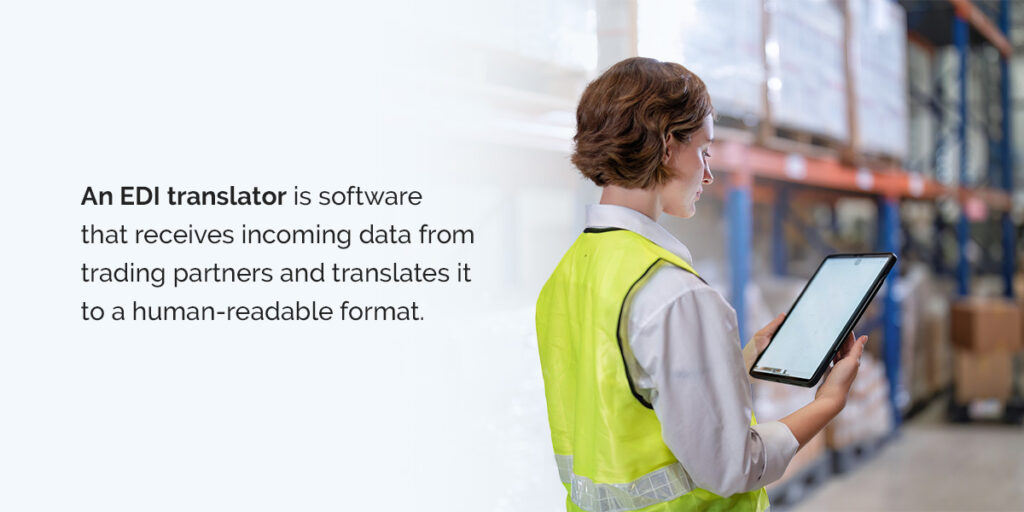Cloud EDI vs. On-Premises EDI

October 18, 2023
Efficiently communicating order data is critical for business growth. For years, companies have relied on electronic data interchange (EDI) to speed up order processing, reduce errors, and comply with trading partner requirements.
Traditionally, businesses managed this with on-premise EDI software hosted on in-house servers. Today, many suppliers are switching to cloud-based EDI solutions for greater flexibility, scalability, and lower costs. But which is right for your business? Let’s compare cloud EDI vs. on-premise EDI so you can choose the best approach.
What is Cloud EDI?
Cloud EDI (also called cloud-based EDI or web EDI) runs on the cloud instead of local servers. Instead of managing in-house infrastructure, businesses rely on an EDI cloud solutions provider to handle hosting, monitoring, updates, and compliance. This makes it easier to scale and reduces the burden on internal IT teams.
Key Components of Cloud-Based EDI Solutions
An EDI solutions provider
Companies that want to use EDI in the cloud must go through an EDI solutions provider. An EDI solutions vendor provides the servers and network needed to operate web-based EDI and IT support to ensure messages flow smoothly.
A web-based EDI translator
Companies use a web-based EDI translator to format EDI transactions to meet business needs.
A network
Web-based EDI solutions require a secure network dedicated to sending and receiving EDI transactions. Some types of networks for EDI transactions are Value Added Networks (VANs) and Single Channel Networks.
However, VANs require manual document processing, and Single Channel Networks make it difficult to expand across different sales channels. Many companies choose a multi-enterprise commerce network, which provides one global network that connects thousands of trading partners.
Pros and Cons of Cloud EDI
Like any technology, cloud-based EDI solutions come with advantages and potential drawbacks. Understanding these helps you choose the best EDI approach for your business.
Pros of Cloud EDI
Reduced costs
Traditional EDI solutions require businesses to buy and install large data servers. Cloud-based EDI doesn’t require any of these upfront costs, instead charging a single monthly price for the use of the system.
No need to maintain the system
With web-based EDI, the EDI solutions provider handles all aspects of hardware maintenance, including the cost of replacing server components. The solutions provider also maintains a team of IT professionals to ensure EDI transactions run smoothly, so their customers have no responsibility to maintain the system.
These features make cloud-based EDI an excellent solution for businesses without in-house EDI expertise or with lean teams.
Ease of scaling
Cloud-based scales seamlessly, providing the adaptability your company needs to work with any trading partner. When you need to scale your cloud EDI use up or down, your EDI solutions provider works with you to adjust your package.
The provider provides additional server space if needed, and your team doesn’t have to install new software or hardware.
Eliminated manual data entry
Entering EDI transaction data into your company’s enterprise resource planning (ERP) or accounting system is inefficient. With web-based EDI, you can integrate EDI data with your business system automatically.
Data syncs instantly across all systems and applications. Employees can focus on higher-priority tasks, boosting efficiency.
Cons of Cloud EDI
Less control
When a company outsources its EDI solution, it gives up some control. Companies can’t update the software or change an aspect of their operation without consulting with the EDI solutions provider.
Switching providers
If you ever decide your company would benefit from a different EDI solution, you must research different providers and select a new one. If you had an in-house EDI system, you could make the changes you wanted. However, that process could also be time-consuming.
What is On-Premises EDI?

On-premises EDI (sometimes called on-premise EDI software) runs on servers hosted within your company’s own IT infrastructure. Instead of relying on a cloud EDI provider, businesses purchase and maintain their own servers, software, and in-house support teams to manage the EDI system.
This approach gives companies full control over their EDI environment, but it also requires significant investment in hardware, software, and skilled IT staff.
Key Components of On-Premises EDI
- EDI translator: Software that receives and converts EDI messages into readable formats.
- In-house servers: Local servers dedicated to running the EDI solution, plus backup and redundancy systems.
- Support staff: IT teams responsible for maintaining servers, handling errors, and managing trading partner requirements.
Pros of On-Premises EDI
Although on-premises EDI is no longer the only EDI solution available, the method is still popular with some companies. Here are a few reasons why it might make sense to use on-premises EDI:
- Complete control: Manage data security, access, and system updates internally.
- Customisable: Adapt the solution to specific business processes or requirements.
- Useful for lower order volumes: Can be manageable for smaller businesses with limited EDI traffic.
Cons of On-Premises EDI
On-premises EDI solutions also come with unique disadvantages. Companies should weigh the cons when considering whether to use this solution:
- High costs: Expensive upfront investment in servers, licenses, and IT staff.
- Maintenance burden: Your team must handle updates, compliance, and problem resolution.
- Difficult to scale: Growth requires buying more servers and increasing IT resources.
- More manual work: Often requires manual entry of EDI data into ERP or accounting systems.
- Complexity: Managing multiple partner requirements can overwhelm even large IT teams.
Why a Hybrid Model is Best
Today’s trading partners need modern EDI solutions to maintain a competitive edge and meet modern demands. When you want the benefits of a web-based EDI system and the control that an on-premises EDI solution provides, a hybrid EDI model may work best.
A hybrid approach lets you work with an EDI solutions provider to create a system that meets your business needs. For example, integrating EDI with your ERP system allows you to continue using your company’s mission-critical ERPs, including leading systems like Acumatica, Oracle NetSuite, Intuit, Sage Intacct and X3, and SAP.
Working with TrueCommerce to integrate your EDI, and the ERP system of your choice, allows you to build a solution that integrates seamlessly with your tech stack and provides all the benefits of cloud EDI.
Stay Connected to Trading Partners With Cloud EDI
Staying connected to your trading partners is more critical than ever in today’s market. A robust cloud EDI solution eliminates inefficiencies, reduces manual work, and ensures documents flow automatically between systems.
TrueCommerce’s cloud-based EDI software provides:
- Easy scalability: Expand quickly to new trading partners or markets.
- Simpler maintenance: We handle hosting, updates, and monitoring for you.
- ERP integration: Connect directly to systems like Sage 100 Cloud, Sage 300 Cloud, Oracle Cloud, and SAP.
- Global connectivity: Access a network of thousands of trading partners.
If you’re searching for the best cloud-based EDI solution for long-term growth, TrueCommerce is the trusted choice.
Request a free EDI demo today and see how TrueCommerce cloud EDI can transform the way you do business.

FAQ: Cloud, On-Premises, and Hybrid EDI
What are the benefits of cloud EDI?
The key benefits of cloud-based EDI software include reduced costs, simplified maintenance, easier scaling, ERP integration, and automated data exchange. Cloud EDI also connects you to global trading networks without requiring in-house IT infrastructure.
Which ERP systems integrate with cloud EDI?
TrueCommerce cloud EDI integrates with leading ERP systems such as SAP, Oracle NetSuite, Sage 100 Cloud, Sage 300 Cloud, Acumatica, Intuit, and Sage Intacct.
What is the difference between cloud EDI and on-premises EDI?
Cloud EDI runs on a provider’s servers and is delivered as a managed service, while on-premises EDI runs on your company’s own servers and requires internal IT support. Cloud EDI is easier to scale, while on-premises EDI offers more direct control.
Share this post:
Stay ahead of the competition
Get expert supply chain insights delivered directly to your inbox weekly.